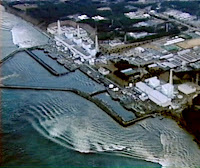Vermont Yankee is Not Fukushima
 Vermont Yankee is not Fukushima
Vermont Yankee is not FukushimaOn March 11, 2011, a massive earthquake and tsunami struck Japan. Schools collapsed, villages were swept out to sea, and an estimated 20,000 people died.
Five nuclear stations containing fifteen reactors were affected by the tsunami. All the reactors survived the earthquake, but transmission lines failed and diesel generators were flooded. At one site, three reactors lost power for too long, resulting in fuel damage, hydrogen explosions and radiation release. In accordance with emergency plans, population evacuations began almost immediately.
Japan is an industrial powerhouse and technically astute country. The question arises: Could it happen here? Specifically, could this happen at Vermont Yankee, a sister reactor to those in Fukushima?
Vermont Yankee Safeguards
Worldwide, plants have operated through hurricanes, floods and tornados, as well as earthquakes. Shortly after Fukushima, a prominent anti-nuclear activist worried that a meltdown could happen to Vermont Yankee if a big hurricane came to the Connecticut River Valley. A few months later, Hurricane Irene arrived. During the storm, roads washed away and neighboring towns were flooded. Vermont Yankee still made power at full capacity. Nuclear plants are among the sturdiest structures on the planet. Vermont Yankee is designed for a 500-year-flood, 360 mph tornado winds, and severe earthquakes.
To operate safely, a nuclear plant needs adequate cooling water and electricity. Vermont Yankee draws water from Vernon Pond and also stores millions of gallons on-site. It has several types of electrical backup. Its diesel generators are above the 500-year-flood level. The plant also has a direct power line to Vernon Dam. River water can be pumped directly into the reactor, if necessary. Vermont Yankee is well-engineered for its location.
Vermont Yankee is a Mark 1-Reactor, a design that has worked well in floods, earthquakes, hurricanes and typhoons worldwide. Its reliability is well-tested.
What if it did happen here?
No matter how low the chances of an accident, people wonder what would happen if it DID happen here. In Japan, three reactors failed, but no workers died of direct radiation exposure (unlike Chernobyl). About fifty workers sustained exposures that may increase their risk of eventual cancer by 5% or less. There were no civilian deaths from direct radiation. Civilian radiation exposures are far below the level (100 millisieverts a year) at which epidemiologists can detect measurable increases in eventual cancer. Still, the radiation in the area is higher than before the accident, and a twelve-mile radius has been evacuated. Anxiety and fear have been major effects of the accident.
The facts are clear - there have been no radiation-related deaths to date from the accident at Fukushima, and few (if any) excess cancer deaths can be expected among civilians. Other sources of electricity cause far more illness and death. In America, 50% of our electricity comes from coal. According to the EPA, 32,000 Americans die annually due to pollution from coal plants. When politicians say “We can close Vermont Yankee because there is plenty of excess power available on the grid,” they mean “The fossil plants upwind of us will run more.”
The anniversary of Fukushima will bring outcries, demonstrations, and imaginative scenarios of nuclear doom. But for asthmatics and their families, doom is upwind of us, right now. It’s fossil-fired.
You can return to the main Market News page, or press the Back button on your browser.

